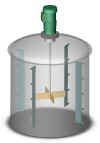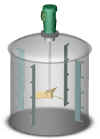|
|
|
|
Standards
|
This is a continuation of the
Process Intensifier - Optimization with CFD: Part 1 paper.
Standard Configurations
| Case R |
Case A |
 |
 |
| Fig. 6: Case R
(RP4 radial
impeller)
click on the picture for a bigger picture |
Fig 7: Case A (
PBT
axial impeller) click on the
picture for a bigger picture |
Two other configurations were used for this study. In both cases standard
vertical cylindrical tanks were used with 4 full height
baffles. The fluid was
water and filled to a liquid depth (Z) equal to the tank diameter (T). Each tank
had a single impeller mounted at a 1/3 Z from the bottom. Case R (Figure 6) had
the radial impeller used for Model LTR. Case A (Figure 7) had the axial impeller
used for both Models LTA and HGA in the down-pumping mode. These tests were done
using the CFD program ACUSOLVE. Since these configurations are more common, the
outputs of the CFD program could be readily compared to literature results. It
is important that the CFD power numbers are similar to experimentally determined
values since it is the power from the impellers that creates the flow patterns
in the tank. If the power dissipated is incorrect in the CFD model, how could
anything else be reliable?
Continue with Experimental Design subtopics...
Dual Radial Process Intensifiers
Axial Impeller Process Intensifiers
CFD Solid Shape Models
or skip the Experimental Section and Continue with Results
or Go back to the
Title Page
|
|
|
